

Tutorial: removing sleevecap ease. After much prodding, here is my tutorial for dealing with sleevecap ease!
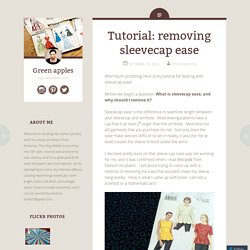
Before we begin, a question: What is sleevecap ease, and why should I remove it? Sleevecap ease is the difference in seamline length between your sleevecap and armhole. Most sewing patterns have a cap that is at least 2″ larger than the armhole. Most (but not all) garments that you purchase do not. Not only does the ease make sleeves difficult to set in neatly, it also (for me at least) causes the sleeve to bind under the arms. I decided pretty early on that sleeve cap ease was not working for me, and it was confirmed when I read this post from Fashion Incubator.
Here is the pattern I’m going to make. Materials: Seam gauge or flexible ruler Clear acrylic quilting rule French curve (optional) A note about materials: You can make due with a seam gauge, and that’s what I’ve used here, since I figure everyone has one. Begin by cutting and pressing your pattern pieces. Now you will need to fold out the excess. Like this: DawnPages. Bias 101. By Marcy Tiltonfrom Threads #76, pp. 34-39 The bias is spoken of in hushed, reverential terms in the fashion world.
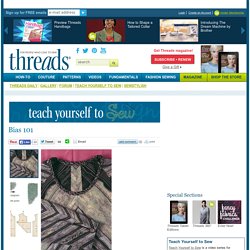
Only a few designers ever master the bias cut, and very few home sewers dare to take the plunge. But by choosing a stable fabric and a simple pattern (a combination I call my "bias training wheels"), and by following a few step-by-step guidelines, you can be assured of success with bias-cut garments. Grain refers to the straight and crosswise direction of the yarns making up a woven fabric, with bias running at any angle to the straight and crossgrains and the true bias running at a 45-degree angle to these grains, as shown in the drawing above.
Sewing Techniques, Tutorials, Lessons, Videos, Photos. Fashion Incubator » Tutorials. New here?
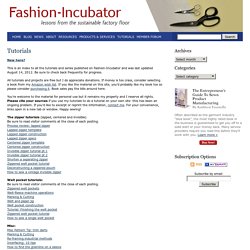
This is an index to all the tutorials and series published on Fashion-Incubator and was last updated August 14, 2012. Be sure to check back frequently for progress. All tutorials and projects are free but I do appreciate donations. If money is too crass, consider selecting a book from my Amazon wish list. If you like the material on this site, you’d probably like my book too so please consider purchasing it.
You’re welcome to the material for personal use but it remains my property and I reserve all rights. The zipper tutorials (lapped, centered and invisible) Be sure to read visitor comments at the close of each posting. Welt pocket tutorials: Be sure to read visitor comments at the close of each posting. Jacket, vest and leather tutorials Also see the “nameless tutorial series” below this heading. Nameless Tutorial series aka the facing/lining/hem juncture in tailored jackets and suits (jacket bagging).
Machine Needles. Selecting the correct needle for your project is just as important as selecting the fabric, thread and stabilizer.
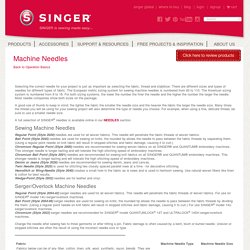
There are different sizes and types of needles for different types of fabric. The European metric sizing system for sewing machine needles is numbered from 60 to 110. The American sizing system is numbered from 8 to 18. For both sizing systems, the lower the number the finer the needle and the higher the number the larger the needle. Sewing-Machine Needles: An Overview. Standard needles Learn to recognize the many types of standard, decorative, and special-purpose machine needles.
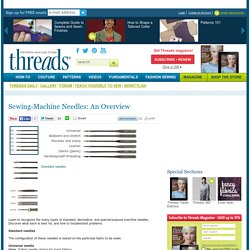
Discover what each is best for, and how to troubleshoot problems. Standard needlesThe configuration of these needles is based on the particular fabric to be sewn. Universal needleUses: Safest needle choice for most fabrics.Configuration: Has slightly rounded point and elongated scarf to enable almost foolproof meeting of needle and bobbin hook.Troubleshooting: When fabric is not medium-weight woven, consider needle specifically suited to fabric.
For example, size 18 universal needle works on heavy denim, but size 18 jeans needle works better.Ballpoint and stretch needlesUses: Ballpoint needle for heavier, looser sweater knits; stretch needle for highly elastic fabrics, likeSpandex, or Lycra.Configuration: Both have rounded points that penetrate between fabric threads rather than pierce them. How to Choose a Needle for Machine Sewing. Machine-Needle Know-How. By Lydia Morganfrom Threads #94, pp. 59-61 Lay out an assortment of sewing-machine needles in various types and sizes on a table, and most of us can't tell the difference among them.

But put the wrong needle in your machine, or use the wrong needle for your fabric and/or thread, and all heck breaks loose. You can damage your bobbin hook, throw off the machine's timing, get puckered seams, break or shred thread, punch holes in your fabric, and, at the very least, produce an inferior stitch. Whatever your machine, even the latest computerized model, needle selection can make or break your stitch. At one time, only one type of machine needle was available to home sewers, and the sole choice involved was size. But today, home sewers can choose from a wide variety of needle types in their quest for trouble-free sewing.